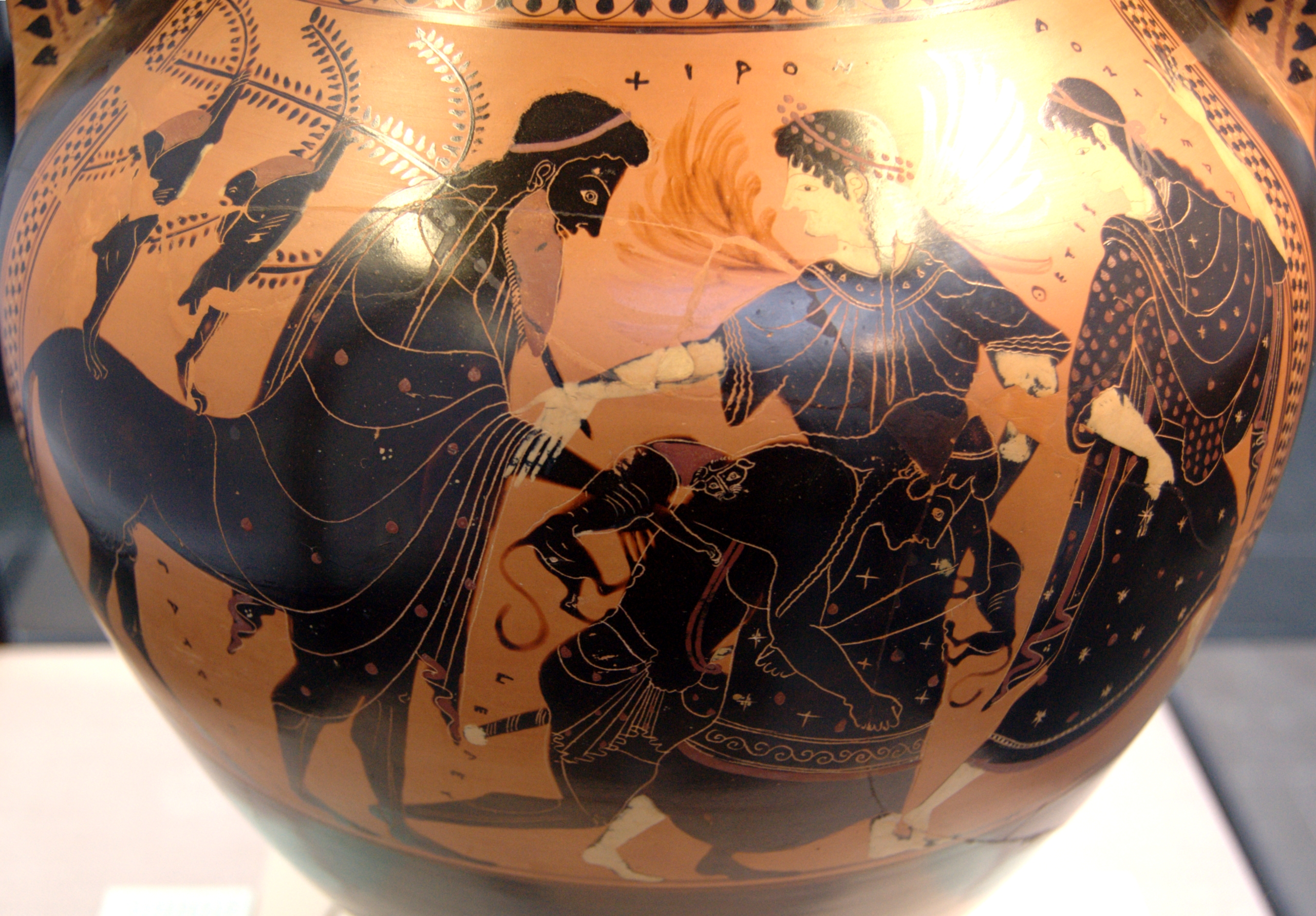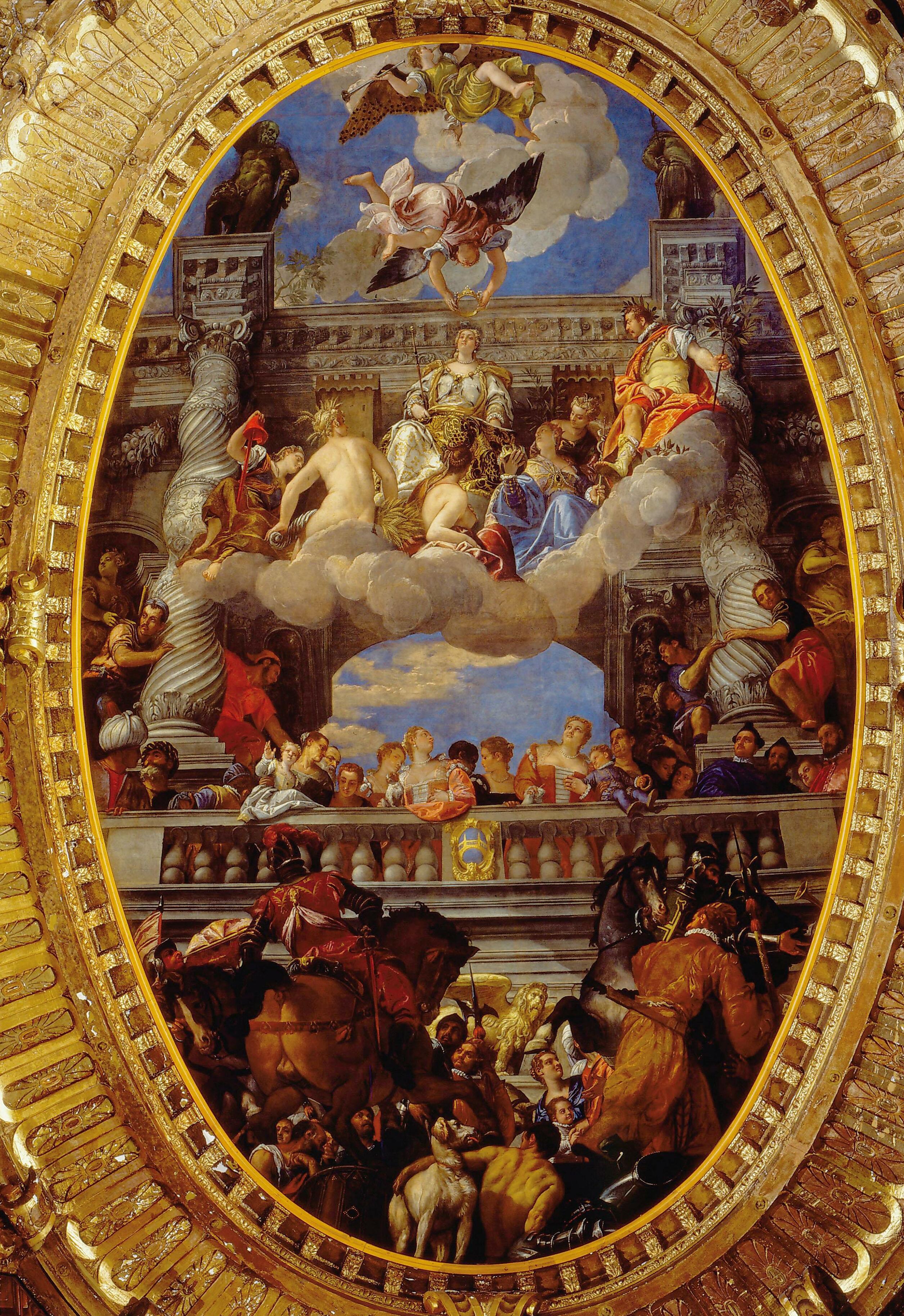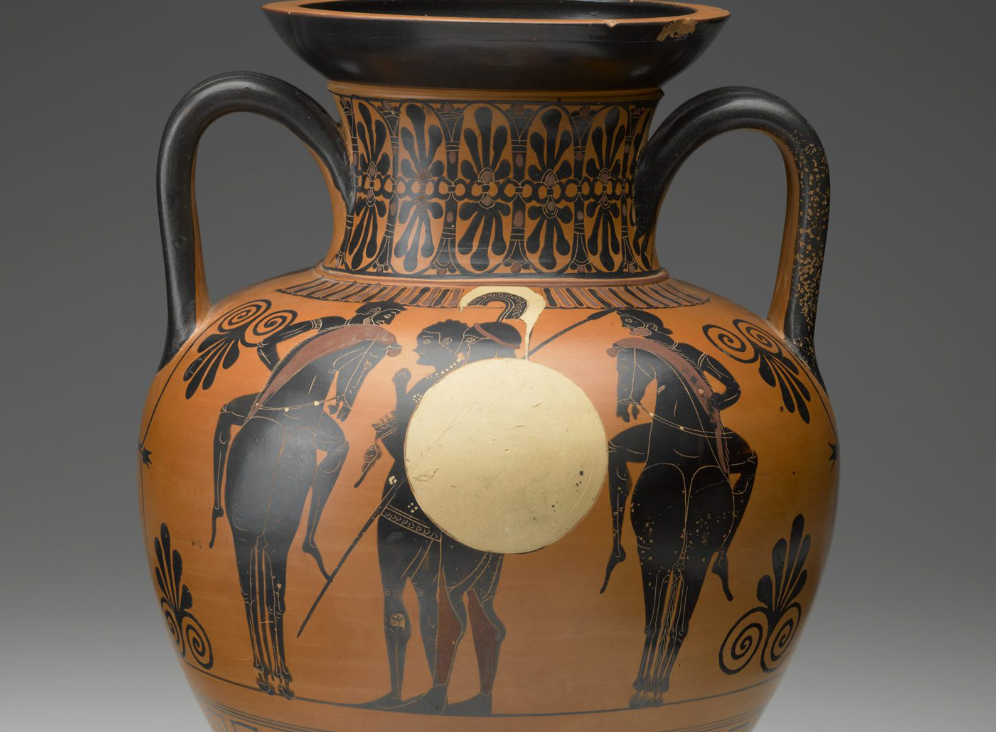|
Monteleone Chariot
The Monteleone chariot is an Etruscan chariot dated to c. 530 BC, considered one of the world's great archaeological finds. It was uncovered in 1902 in Monteleone di Spoleto, Umbria, Italy, in an underground tomb covered by a mound, and is currently a major attraction in the collection of the Metropolitan Museum of Art in New York City. Though about 300 ancient chariots are known to still exist, only six are reasonably complete, and the Monteleone chariot is the best-preserved and most complete of all known surviving examples. Carlos Picón, curator of the museum's Greek and Roman department, has called it "the grandest piece of sixth-century Etruscan bronze anywhere in the world". Description The Monteleone chariot was part of a chariot burial, containing the remains of two human corpses, along with two drinking cups. Measuring in height and designed to be drawn by two horses, the chariot itself is constructed of wood covered with hammered bronze plates and carved ivory d ... [...More Info...] [...Related Items...] OR: [Wikipedia] [Google] [Baidu] |
Bronze Chariot Inlaid With Ivory MET DP137936
Bronze is an alloy consisting primarily of copper, commonly with about 12–12.5% tin and often with the addition of other metals (including aluminium, manganese, nickel, or zinc) and sometimes non-metals (such as phosphorus) or metalloids (such as arsenic or silicon). These additions produce a range of alloys some of which are harder than copper alone or have other useful properties, such as ultimate tensile strength, strength, ductility, or machinability. The three-age system, archaeological period during which bronze was the hardest metal in widespread use is known as the Bronze Age. The beginning of the Bronze Age in western Eurasia is conventionally dated to the mid-4th millennium BCE (~3500 BCE), and to the early 2nd millennium BCE in China; elsewhere it gradually spread across regions. The Bronze Age was followed by the Iron Age, which started about 1300 BCE and reaching most of Eurasia by about 500 BCE, although bronze continued to be much more widely used than it is in ... [...More Info...] [...Related Items...] OR: [Wikipedia] [Google] [Baidu] |
Relief
Relief is a sculpture, sculptural method in which the sculpted pieces remain attached to a solid background of the same material. The term ''wikt:relief, relief'' is from the Latin verb , to raise (). To create a sculpture in relief is to give the impression that the sculpted material has been raised above the background Plane (geometry), plane. When a relief is carved into a flat surface of stone (relief sculpture) or wood (relief carving), the field is actually lowered, leaving the unsculpted areas seeming higher. The approach requires chiselling away of the background, which can be time-intensive. On the other hand, a relief saves forming the rear of a subject, and is less fragile and more securely fixed than a sculpture in the round, especially one of a standing figure where the ankles are a potential weak point, particularly in stone. In other materials such as metal, clay, plaster stucco, ceramics or papier-mâché the form can be simply added to or raised up from the bac ... [...More Info...] [...Related Items...] OR: [Wikipedia] [Google] [Baidu] |
Amber
Amber is fossilized tree resin. Examples of it have been appreciated for its color and natural beauty since the Neolithic times, and worked as a gemstone since antiquity."Amber" (2004). In Maxine N. Lurie and Marc Mappen (eds.) ''Encyclopedia of New Jersey'', Rutgers University Press, . Amber is used in jewelry and as a healing agent in Traditional medicine, folk medicine. There are five classes of amber, defined on the basis of their chemical constituents. Because it originates as a soft, sticky tree resin, amber sometimes contains animal and plant material as Inclusion (mineral), inclusions. Amber occurring in coal seams is also called resinite, and the term ''ambrite'' is applied to that found specifically within New Zealand coal seams. Etymology The English word ''amber'' derives from Arabic from Middle Persian 𐭠𐭭𐭡𐭫 (''ʾnbl'' /ambar/, “ambergris”) via Medieval Latin, Middle Latin ''ambar'' and Middle French ''ambre''. The word referred to what is n ... [...More Info...] [...Related Items...] OR: [Wikipedia] [Google] [Baidu] |
Legendary Creature
A legendary creature is a type of extraordinary or supernatural being that is described in folklore (including myths and legends), and may be featured in historical accounts before modernity, but has not been scientifically shown to exist. In the classical era, monstrous creatures such as the Cyclops and the Minotaur appear in heroic tales for the protagonist to destroy. Other creatures, such as the unicorn, were claimed in accounts of natural history by various scholars of antiquity. Some legendary creatures are Hybrid beasts in folklore, hybrid beasts. Some legendary creatures originated in traditional mythology and were believed to be real creatures--for example, dragons, griffins and unicorns. Others are based on real encounters or garbled accounts of travellers' tales, such as the Vegetable Lamb of Tartary, a sheeplike animal which supposedly grew tethered to the earth. Creatures A variety of mythical animals appear in the art and stories of the classical era. For exampl ... [...More Info...] [...Related Items...] OR: [Wikipedia] [Google] [Baidu] |
Animal
Animals are multicellular, eukaryotic organisms in the Biology, biological Kingdom (biology), kingdom Animalia (). With few exceptions, animals heterotroph, consume organic material, Cellular respiration#Aerobic respiration, breathe oxygen, have myocytes and are motility, able to move, can reproduce sexually, and grow from a hollow sphere of Cell (biology), cells, the blastula, during embryonic development. Animals form a clade, meaning that they arose from a single common ancestor. Over 1.5 million extant taxon, living animal species have been species description, described, of which around 1.05 million are insects, over 85,000 are molluscs, and around 65,000 are vertebrates. It has been estimated there are as many as 7.77 million animal species on Earth. Animal body lengths range from to . They have complex ecologies and biological interaction, interactions with each other and their environments, forming intricate food webs. The scientific study of animals is known as ... [...More Info...] [...Related Items...] OR: [Wikipedia] [Google] [Baidu] |
Chiron
In Greek mythology, Chiron ( ; also Cheiron or Kheiron; ) was held to be the superlative centaur amongst his brethren since he was called the "wisest and justest of all the centaurs". Biography Chiron was notable throughout Greek mythology for his youth-nurturing nature. His personal skills tend to match those of his foster father Apollo, who taught the young centaur the art of medicine, herbs, music, archery, hunting, gymnastics, and prophecy, and made him rise above his beastly nature. Chiron was known for his knowledge and skill with medicine, and thus was credited with the discovery of botany and pharmacy, the science of herbs and medicine.Pliny the Elder, ''Natural History (Pliny), Naturalis Historia'7.56.3/ref> Like satyrs, centaurs were notorious for being wild, lusty, overly indulgent drinkers and carousers, violent when intoxicated, and generally uncultured delinquents. Chiron, by contrast, was intelligent, civilized, and kind, because he was not related directly to th ... [...More Info...] [...Related Items...] OR: [Wikipedia] [Google] [Baidu] |
Centaur
A centaur ( ; ; ), occasionally hippocentaur, also called Ixionidae (), is a creature from Greek mythology with the upper body of a human and the lower body and legs of a horse that was said to live in the mountains of Thessaly. In one version of the myth, the centaurs were named after Centaurus (Greek mythology), Centaurus, and, through his brother Lapithes (hero), Lapithes, were kin to the legendary tribe of the Lapiths. Centaurs are thought of in many Greek myths as being as wild as untamed horses, and were said to have inhabited the region of Magnesia (regional unit), Magnesia and Mount Pelion in Thessaly, the Foloi oak forest in Ancient Elis, Elis, and the Malean peninsula in southern Laconia. Centaurs are subsequently featured in Roman mythology, and were familiar figures in the medieval bestiary. They remain a staple of modern fantastic literature. Etymology The Greek word ''kentauros'' is generally regarded as being of obscure origin. The etymology from ''ken'' + ''tau ... [...More Info...] [...Related Items...] OR: [Wikipedia] [Google] [Baidu] |
Boar
The wild boar (''Sus scrofa''), also known as the wild swine, common wild pig, Eurasian wild pig, or simply wild pig, is a Suidae, suid native to much of Eurasia and North Africa, and has been introduced to the Americas and Oceania. The species is now one of the widest-ranging mammals in the world, as well as the most widespread Suina, suiform. It has been assessed as least concern on the IUCN Red List due to its wide range, high numbers, and adaptability to a diversity of habitats. It has become an invasive species in part of its introduced range. Wild boars probably originated in Southeast Asia during the Early Pleistocene and outcompeted other suid species as they spread throughout the Old World. , up to 16 subspecies are recognized, which are divided into four regional groupings based on skull height and lacrimal bone length. The species lives in matriarchal societies consisting of interrelated females and their young (both male and female). Fully grown males are usually s ... [...More Info...] [...Related Items...] OR: [Wikipedia] [Google] [Baidu] |
Apotheosis
Apotheosis (, ), also called divinization or deification (), is the glorification of a subject to divine levels and, commonly, the treatment of a human being, any other living thing, or an abstract idea in the likeness of a deity. The original sense of apotheosis relates to religion and is the subject of many works of art. Figuratively "apotheosis" may be used in almost any context for "the deification, glorification, or exaltation of a principle, practice, etc.", so normally attached to an abstraction of some sort. In religion, apotheosis was a feature of many religions in the ancient world, and some that are active today. It requires a belief that there is a possibility of newly created gods, so a polytheistic belief system. The major modern religions of Christianity, Islam, and Judaism do not allow for this, though many recognise minor sacred categories such as saints (created by a process called canonization). In Christian theology there is a concept of the faithful bec ... [...More Info...] [...Related Items...] OR: [Wikipedia] [Google] [Baidu] |
Memnon
In Greek mythology, Memnon (; Ancient Greek: Μέμνων, ) was a king of Aethiopia and son of Tithonus and Eos. During the Trojan War, he brought an army to Troy's defense and killed Antilochus, Nestor (mythology), Nestor's son, during a fierce battle. Nestor challenged Memnon to a fight, but Memnon refused, being there was little honor in killing the aged man. Nestor then pleaded with Achilles to avenge his son's death. Despite warnings that soon after Memnon fell so too would Achilles, the two men fought. Memnon drew blood from Achilles, but Achilles drove his spear through Memnon's chest, sending the Aethiopian army running. The death of Memnon echoes that of Hector, another defender of Troy whom Achilles also killed out of revenge for a fallen comrade, Patroclus. After Memnon's death, Zeus was moved by Eos' tears and granted him immortality. Memnon's death is related at length in the lost epic ''Aethiopis'', likely composed after ''The Iliad'', circa the 7th century Befo ... [...More Info...] [...Related Items...] OR: [Wikipedia] [Google] [Baidu] |
Troy
Troy (/; ; ) or Ilion (; ) was an ancient city located in present-day Hisarlik, Turkey. It is best known as the setting for the Greek mythology, Greek myth of the Trojan War. The archaeological site is open to the public as a tourist destination, and was added to the List of World Heritage Sites in Turkey, UNESCO World Heritage list in 1998. Troy was repeatedly destroyed and rebuilt during its 4000 years of occupation. As a result, the site is divided into nine Stratigraphy (archaeology), archaeological layers, each corresponding to a city built on the ruins of the previous. Archaeologists refer to these layers using Roman numerals, Troy I being the earliest and Troy IX being the latest. Troy was first settled around 3600 BC and grew into a small fortified city around 3000 BC (Troy I). Among the early layers, Troy II is notable for its wealth and imposing architecture. During the Late Bronze Age, Troy was called Wilusa and was a vassal of the Hittite Empire. The final layer ... [...More Info...] [...Related Items...] OR: [Wikipedia] [Google] [Baidu] |
Gorgon
The Gorgons ( ; ), in Greek mythology, are three monstrous sisters, Stheno, Euryale, and Medusa, said to be the daughters of Phorcys and Ceto. They lived near their sisters the Graeae, and were able to turn anyone who looked at them to stone. Euryale and Stheno were immortal, but Medusa was not and was slain by the hero Perseus. Gorgons were dread monsters with terrifying eyes. A Gorgon head was displayed on Athena's aegis, giving it the power both to protect her from any weapon, and instill great fear in any enemy. Gorgon blood was said to have both the power to heal and harm. Representations of full-bodied Gorgons and the Gorgon face, called a gorgoneion (pl. gorgoneia), were popular subjects in Ancient Greek, Etruscan and Roman iconography. While Archaic Gorgons and gorgoneia are universally depicted as hideously ugly, over time they came to be portrayed as beautiful young women. Etymology The name 'Gorgon' is associated with the Ancient Greek adjective (), which, of ... [...More Info...] [...Related Items...] OR: [Wikipedia] [Google] [Baidu] |








